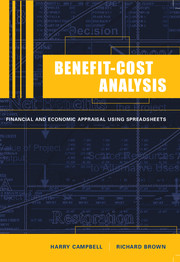Book contents
- Frontmatter
- Contents
- List of figures
- List of tables
- Preface
- Acknowledgements
- 1 Benefit-Cost Analysis: Introduction and Overview
- 2 Investment Appraisal: Principles
- 3 Investment Appraisal: Decision-Rules
- 4 Private Benefit-Cost Analysis: Financial Analysis
- 5 Efficiency Benefit-Cost Analysis
- 6 Calculating the Net Benefits to the Referent Group
- 7 Consumer and Producer Surplus in Benefit-Cost Analysis
- 8 Valuing Traded and Non-traded Commodities in Benefit-Cost Analysis
- 9 Incorporating Risk in Benefit-Cost Analysis
- 10 The Social Discount Rate, Cost of Public Funds, and the Value of Information
- 11 Weighting Net Benefits to Account for Income Distribution
- 12 Valuation of Non-marketed Goods
- 13 Economic Impact Analysis
- 14 Writing the Benefit-Cost Analysis Report
- Appendix 1 Case Study Assignment
- Appendix 2 Discount and Annuity Tables
- Index
2 - Investment Appraisal: Principles
Published online by Cambridge University Press: 05 September 2012
- Frontmatter
- Contents
- List of figures
- List of tables
- Preface
- Acknowledgements
- 1 Benefit-Cost Analysis: Introduction and Overview
- 2 Investment Appraisal: Principles
- 3 Investment Appraisal: Decision-Rules
- 4 Private Benefit-Cost Analysis: Financial Analysis
- 5 Efficiency Benefit-Cost Analysis
- 6 Calculating the Net Benefits to the Referent Group
- 7 Consumer and Producer Surplus in Benefit-Cost Analysis
- 8 Valuing Traded and Non-traded Commodities in Benefit-Cost Analysis
- 9 Incorporating Risk in Benefit-Cost Analysis
- 10 The Social Discount Rate, Cost of Public Funds, and the Value of Information
- 11 Weighting Net Benefits to Account for Income Distribution
- 12 Valuation of Non-marketed Goods
- 13 Economic Impact Analysis
- 14 Writing the Benefit-Cost Analysis Report
- Appendix 1 Case Study Assignment
- Appendix 2 Discount and Annuity Tables
- Index
Summary
Introduction
This Chapter provides a simple introduction to the principles of investment appraisal. It starts with an outline of the logic of the investment appraisal process from the viewpoint of an individual considering a very simple type of project. During the course of the discussion of this process such concepts as the discount rate, discount factor, present value, benefit/cost ratio, marginal productivity of capital and internal rate of return are developed. The discussion then shifts to the economy as a whole and the role of investment appraisal in allocating resources between investment and the production of goods for consumption. The simple algebra of various investment decision-rules applied in the latter part of the Chapter is then presented, followed by a numerical example. Following this, some special concepts, such as annuities, economic depreciation, inflation and risk, are discussed in the context of investment appraisal.
In the following chapter (Chapter 3), the discussion shifts to applications of the various investment decision-rules. Some of the applications rely on the simple algebraic concepts already discussed in Chapter 2, while some are developed using the basic tool of the benefitcost analyst – the spreadsheet. Some issues already raised in this Chapter, such as the time value of money and the calculation of present value and internal rate of return, are explored further, while new concepts, such as comparison of projects and capital rationing are introduced and discussed.
Investment Appraisal from a Personal Viewpoint
Economists start from the proposition that an individual's economic welfare in a given time period is determined by the quantity of goods and services she consumes in that time period; consumption of goods and services is taken to be the ultimate goal of economic activity.
- Type
- Chapter
- Information
- Benefit-Cost AnalysisFinancial and Economic Appraisal using Spreadsheets, pp. 18 - 35Publisher: Cambridge University PressPrint publication year: 2003



